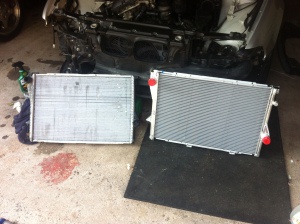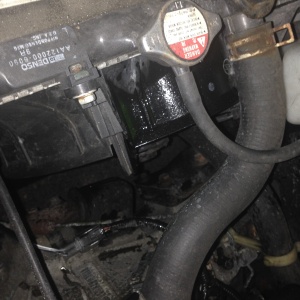- 09/27/2014
- 1 Min Read
- By: Gareth Foley
Why You Need to Replace Your Leaking Radiator ASAP
I pulled out onto the road and noticed steam rising from under the hood, and distinctly remembered looking at my gauge cluster only to see the engine temperature rising quickly past the midway point. Needless to say, I immediately pulled off the road and turned the engine off to let it cool down. Without even looking I knew immediately that my radiator had failed catastrophically. I think everyone at some point has experienced this situation (unless you drive an air-cooled car) and needless to say, it isn't fun. There is never a good time for a radiator to fail and it always seems to happen at the most inopportune time. However, not all radiator failures occur catastrophically. Many radiators develop warning signs of imminent failure even before you get to the level I just described.
Heat from coolant is transferred to the core
Before continuing this discussion, let's discuss the purpose and function of a radiator. In general, a radiator is a heat exchanger that uses convection to transfer heat from its liquid coolant/water into its surrounding environment. All radiators function in this way. In your car, heated coolant from the engine enters the inlet tank of the radiator (called the hot side) which then flows through the radiator core via a network of tubes. Heat transfer is further encouraged via the fins located between the radiator tubes. As the coolant travels through the radiator core heat from the coolant is transferred to the core which is then transferred to the ambient air. For the radiator to function optimally, it will need a larger volume of air in relation to coolant in order to function optimally.
Radiators, like any other component on your car, will wear out and eventually need replacement. Most newer cars use a radiator with an aluminum core with plastic end tanks, there are exceptions to this rule. I will be primarily discussing the common signs of wear with this style of radiator. An overheating condition is not always indicative of a failed radiator and a radiator can be leading to failure without causing an overheating condition.
When a radiator leaks the boiling point lessens
My most recent radiator issue was an obvious one. My engine was overheating while sitting at a standstill in traffic and I could see a little bit of steam coming from the front of my car. The inlet of the radiator was leaking a substantial amount of coolant. I did not need to look any further to determine that the radiator had failed. Generally speaking when your vehicles radiator leaks the boiling point for the coolant becomes lower, which is why your vehicle will start to overheat. Fortunately, this incident occurred on a 1997 Honda Civic and replacing the radiator was about as easy as it could get.

Another incident that happened a few years back still perplexes me to this day. My BMW 528i had had its radiator recently replaced with an OE Behr unit. I happened to notice that a little bit of dried coolant could be seen on the side of the radiator outlet (cool side) This small amount of coolant eventually turned into a noticeable leak. Despite this leak my car would not overheat. I assume this was the case because the leak was very small and the car in question has a relatively larger coolant capacity. Despite not having any overheating conditions I decided to replace the radiator anyway, eventually getting a fancy all aluminum version to replace the failure-prone OE style radiator.
The bottom line is, your vehicle's radiator is an important part of your vehicles cooling system. Without it your car would not be able to expel heat. In a perfect world, a car shouldn't leak any fluid and a fluid leak is an indicator of a problem. If any part of your vehicle's cooling system is leaking replace it immediately and save yourself the agony of other complications. A warped head or a blown head gasket is not worth the cost of driving around with a leaking or damaged radiator.












